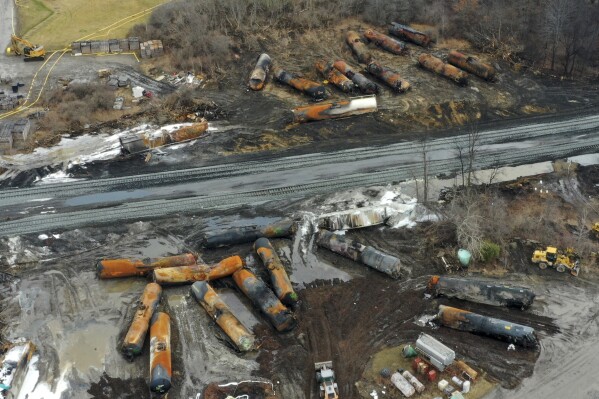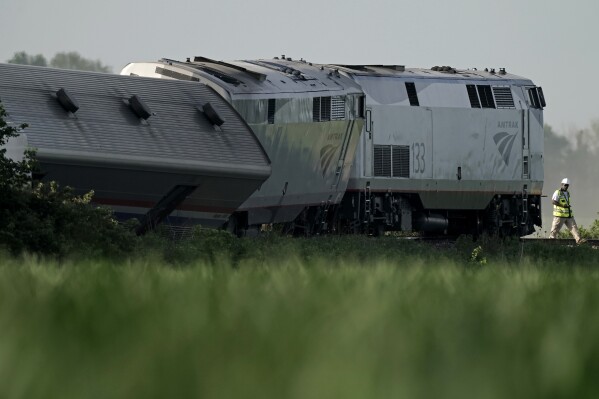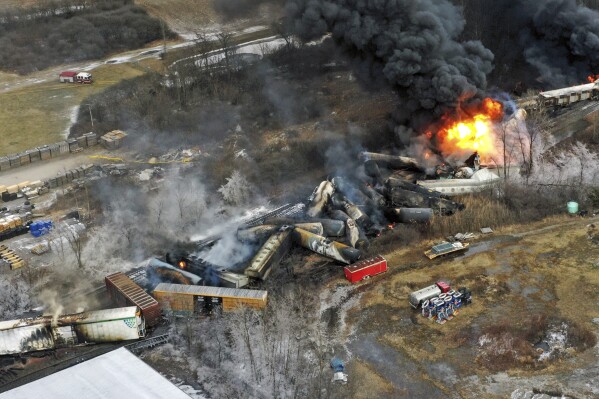Missouri budgets $50M for railroad crossings in response to fatal 2022 Amtrak derailment
JEFFERSON CITY, Mo. (AP) — Missouri Gov. Mike Parson and state transportation officials on Thursday outlined options for spending the first chunk of $50 million budgeted for railroad crossing improvements in an effort to prevent tragedies like last year’s fatal Amtrak derailment.
The National Transportation Safety Board said Wednesday that poor design contributed to the derailment in the north-central Missouri town of Mendon , which killed four people and injured 146 others.
Recommendations from a $750,000 study unveiled Thursday suggest changes at 47 public rail crossings on three tracks that carry passenger trains throughout Missouri for a total cost of about $18.5 million. Total closure is recommended at 17 crossings, including the Mendon site where the crash occurred.
The rest of the $50 million is planned for improvements at freight train crossings.
 6 months after the East Palestine train derailment, Congress is deadlocked on new rules for safety
6 months after the East Palestine train derailment, Congress is deadlocked on new rules for safety
 Poorly designed crossing contributed to fatal 2022 Missouri Amtrak derailment, officials say
Poorly designed crossing contributed to fatal 2022 Missouri Amtrak derailment, officials say
 Norfolk Southern changes policy on overheated bearings, months after Ohio derailment
Norfolk Southern changes policy on overheated bearings, months after Ohio derailment
The 27 crossings slated for improvements do not have lights, barriers or other alerts to warn drivers when a train is approaching. There are more than 1,400 such crossings throughout Missouri, according to the state Transportation Department.
Spokeswoman Linda Horn said the cost for fixing all passive crossings is estimated at $700 million.
The Mendon crossing, which was shuttered immediately after last year’s crash, also had no lights or signals to warn that a train was approaching.
Before the crash, area residents had expressed concerns for nearly three years about the safety of the crossing because of the lack of visibility.
“Just setting eyes on it, you realize how dangerous it was,” NTSB Chair Jennifer Homendy said.
The state Transportation Department had put the $400,000 project to add lights and gates at the crossing on a priority list, but it hadn’t received funding before the derailment.
“Mendon was a wake-up call,” Missouri Department of Transportation Director Patrick McKenna told reporters Thursday.
Roughly half of all rail crossings nationwide — some 130,000 of them — are considered passive without any lights or arms that automatically come down when a train is approaching.
For years, the NTSB has recommended closing passive crossings or adding gates, bells and other safety measures whenever possible. The U.S. Transportation Department recently announced $570 million in grants to help eliminate railroad crossings in 32 states but that funding will only eliminate a few dozen crossings.
Federal statistics show that roughly 2,000 collisions occur every year at rail crossings nationwide, and last year nearly 250 deaths were recorded in car-train crashes.
Those killed in the Amtrak derailment included the dump truck driver, 54-year-old Billy Barton II, of Brookfield, Missouri, and three passengers: Rochelle Cook, 58, and Kim Holsapple, 56, both of DeSoto, Kansas, and 82-year-old Binh Phan, of Kansas City, Missouri.
The Missouri State Highway Patrol said up to 150 people also were injured.
The Southwest Chief was traveling from Los Angeles to Chicago when it hit the rear right side of the truck near Mendon. Two locomotives and eight cars derailed. The train had 12 crewmembers and 271 aboard.
Following the derailment, several lawsuits were filed against BNSF, a Fort Worth, Texas-based freight railroad that owns and maintains the tracks involved.
Homendy on Thursday said there’s shared responsibility between the county, which owns the road, and BNSF.
“But ultimately, it’s BNSF’s railroad,” she said. “It’s their rail line, and they have to make sure everybody is safe on that line.”
She said the railroad repaired the track within hours of the accident.
“If you can make those improvements to get critical shipments of freight on your rail line, you can also make safety improvements in a quick amount of time,” she said.
An email by The Associated Press seeking comment from BNSF was not immediately returned Thursday. But a BNSF spokesperson previously said the railroad will review the NTSB report closely for suggestions to improve rail crossing safety.
“We continue to invest in grade crossing safety by maintaining crossings, working to help develop public service campaigns and educational resources and investing in new technologies,” the railroad said in a Wednesday statement.
Disclaimer: The copyright of this article belongs to the original author. Reposting this article is solely for the purpose of information dissemination and does not constitute any investment advice. If there is any infringement, please contact us immediately. We will make corrections or deletions as necessary. Thank you.



